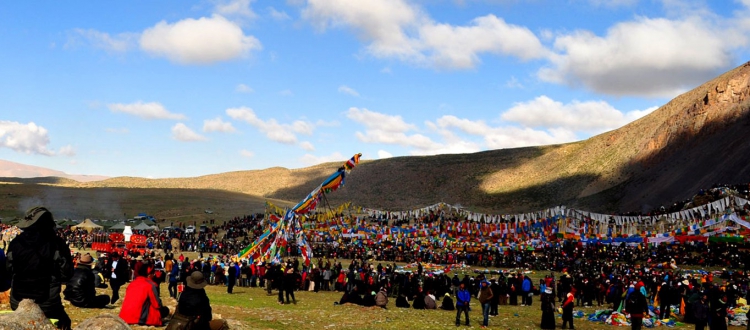The Yogurt Festival / Sho Dun Festival
The Sho Dun Festival is commonly known as the Yogurt festival and is an annual festival that is celebrated at Norbulingka or “Jewel Park” palace in Lhasa, Tibet. It is named yoghurt festival because yoghurt is offered to the monks who happen to finish their meditation retreats.
It is a week-long gala celebrated in the summer, from the 15th to the 24th of the 5th lunar month. It usually falls on the mid of August. This year it is from August 11th to August 16th. It is especially dedicated to the monks
The festival is celebrated in the summer, from the 15th to the 24th of the 5th lunar month – usually about the middle of August, after a month’s retreat by the monks who stay within their monasteries to avoid walking on the emerging summer insects and killing them.
This tradition is believed to have been started from the 16th century with a banquet given by the lay people for the monks featuring yoghurt. Slowly and gradually, summer operas, or Lhamo, and theatricals were included in the festival. Dancers from all over the Tibet come to the festival and perform in the melodious chorus.
The grounds, stones and walls around Norbulingka are filled up with a colourful canvas of Buddhist deities. There is much dining and visiting between family groups and nights are filled with bonfires.
A big thangka is showcased every year.
What to See in Sho Dun Festival?
- Gathering of Thousands of Tibetan people at Drepung and Sera monastery with well ethnic dress up.
- One can see Lama with giant Jampa Thangka and be hanging on the foothill of Gebeiwotse mountain in the early dawn
- The melodious sound of sutra bugle rebounding through the valley.
- Drepung and Sera monastery presenting Giant hanged Jampa thangka.
- Classic Tibetan Opera performance at the Norbulingka Palace.
- Racing of yaks and horsemanship display.
- Sangsol (burning of Tuja leaves along with Tsampa and butter) at the whole cities.
- The crowd of visitors throwing White Khada on the giant Thangka.
Last year the giant Thangkas of Buddha was exhibited at Drepung and Sera Monastery on an early morning of August 21st.










